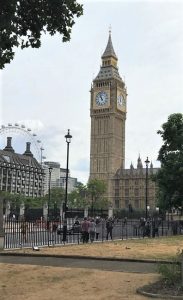 “London is inexhaustible,” as Frommer’s so quaintly puts it, “you could tour it for months and barely get to know it.”
“London is inexhaustible,” as Frommer’s so quaintly puts it, “you could tour it for months and barely get to know it.”
Which means, of course, if you don’t make definitive sightseeing plans, you will find yourself suffering from that dreaded “overchoice” syndrome, a cognitive impairment in which people have great difficulty making a decision when faced with so many options.
Fortunately, my traveling companion and I are pretty much of the same mind… as we had most of our plans for London mapped out before setting foot in the United Kingdom.
Since we had visited the British Museum and the National Gallery on previous occasions, we crossed those off the list and turned our attention to other possibilities, the highlights of which are noted immediately below…
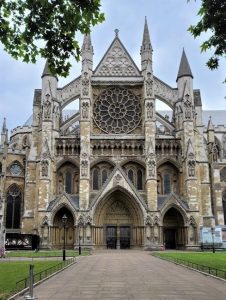
Westminster Abbey: If there is one church in London that is simply not to be missed, it is, without doubt, the Collegiate Church of Saint Peter at Westminster… better known as Westminster Abbey.
The current building dates from the 1200s, but it was part of a monastery dating to at least 960. The church was originally part of a Catholic Benedictine abbey, which was dissolved in 1539. It then served as the cathedral of the Diocese of Westminster until 1550, then as a second cathedral of the Diocese of London until 1556. The abbey was restored to the Benedictines by Mary I in 1556, then in 1559 made a royal peculiar – a church responsible directly to the sovereign – by Elizabeth I.
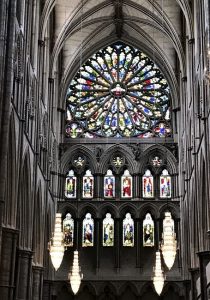 Since the coronation of William the Conqueror in 1066, all coronations of English and British monarchs have occurred in Westminster Abbey (with three exceptions: Edward V, Edward VIII, and possibly Mary I). Sixteen royal weddings have been held at the here since 1100.
Since the coronation of William the Conqueror in 1066, all coronations of English and British monarchs have occurred in Westminster Abbey (with three exceptions: Edward V, Edward VIII, and possibly Mary I). Sixteen royal weddings have been held at the here since 1100.
The abbey is the burial site of more than 3,300 people, all prominent in British history: 17 monarchs, eight prime ministers, poets laureate, actors, scientists, military leaders, and the Unknown Warrior. The royal tombs are near the high altar, where coronations and funerals are conducted.
Once again, I would tend to be in agreement with Frommer’s assessment: “Westminster is more like time’s attic, packed with artifacts, memorials, tombs, and virtuosic shrines – a confluence of God, art, and dense history… There are stories to be told in every square meter of this place – name another building where there is such a staggering continuity of a nation’s heritage.”
The South Transept, for example, is the Poet’s Corner, where plaques honor the country’s great writers: Shakespeare, Austen, Caroll, Wilde, and the Brontës. Those actually interred here include Robert Browning, Geoffrey Chaucer, Charles Dickens, Thomas Hardy, John Gay, Rudyard Kipling, George Frideric Handel, Dr. Samuel Johnson, Laurence Olivier, Edmund Spenser, and Alfred Lord Tennyson.
 Buried in the nave are playwright Ben Jonson, Isaac Newton, Charles Darwin, and the latest addition, theoretical physicist Stephen Hawking.
Buried in the nave are playwright Ben Jonson, Isaac Newton, Charles Darwin, and the latest addition, theoretical physicist Stephen Hawking.
When visiting London, there is absolutely no question that Westminster Abbey is a must-see – just ask the 1.3 million annual visitors – so come early in the day, as the entry lines can be formidable.
 Buckingham Palace: Located in the City of Westminster, Buckingham Palace is the royal residence and administrative headquarters of the monarch of the United Kingdom. Originally known as Buckingham House, the building at the center of the palace was a large townhouse built for the Duke of Buckingham in 1703 on a site that had been a private residence for over 150 years. It was acquired by King George III in 1761 for Queen Charlotte and then became known as the Queen’s House. During the 19th century, it was enlarged by architects John Nash and Edward Blore, who constructed wings around a central courtyard. Buckingham Palace became the London residence of the British monarch on the accession of Queen Victoria in 1837.
Buckingham Palace: Located in the City of Westminster, Buckingham Palace is the royal residence and administrative headquarters of the monarch of the United Kingdom. Originally known as Buckingham House, the building at the center of the palace was a large townhouse built for the Duke of Buckingham in 1703 on a site that had been a private residence for over 150 years. It was acquired by King George III in 1761 for Queen Charlotte and then became known as the Queen’s House. During the 19th century, it was enlarged by architects John Nash and Edward Blore, who constructed wings around a central courtyard. Buckingham Palace became the London residence of the British monarch on the accession of Queen Victoria in 1837.
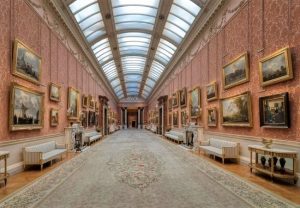 The last major structural additions were made in the late 19th and early 20th centuries; these included the East Front, which contains the balcony on which the royal family traditionally appears to greet crowds. During the Second World War, a German bomb destroyed the palace chapel. The Queen’s Gallery was then built on the site and opened to the public in 1962 to exhibit works of art from the royal collection.
The last major structural additions were made in the late 19th and early 20th centuries; these included the East Front, which contains the balcony on which the royal family traditionally appears to greet crowds. During the Second World War, a German bomb destroyed the palace chapel. The Queen’s Gallery was then built on the site and opened to the public in 1962 to exhibit works of art from the royal collection.
The palace contains 775 rooms; and the palace garden is the largest private garden in London. Public tours (which are conducted approximately two months of the year while the monarch is in Scotland), in my opinion, aren’t terribly exciting, as they will only guide you through the public and ceremonial rooms at the rear of the palace and nowhere near where the royal family actually resides.
The highlight of my recent tour of the palace was most assuredly the Picture Gallery noted immediately above. In honor of the Queen’s Platinum Jubilee, the various works of art, which normally grace several of the royal residences, were brought together in one place – and the result was a truly inspiring exhibition.
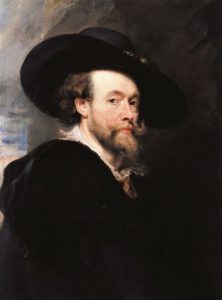 One of the most interesting works, at least from this writer’s perspective, was the Self-Portrait by Flemish artist Peter Paul Rubens (1577-1640). This painting has an interesting history, but I will spare the behind-the-scenes drama by simply saying that in 1621 Rubens sent a (now lost) painting, The Lion Hunt, to England, not realizing that it was intended for Charles, Prince of Wales (who would become King Charles I). It was returned after being recognized as a “studio work” (finished by Ruben’s assistants). This Self-Portrait was subsequently sent as an apology two years later. Charles I clearly admired this painting and hung it alongside self-portraits of Van Dyck and Daniel Mytens in the breakfast chamber at Whitehall. This room was located next to the bedchamber and would likely have been seen by the King on a daily basis.
One of the most interesting works, at least from this writer’s perspective, was the Self-Portrait by Flemish artist Peter Paul Rubens (1577-1640). This painting has an interesting history, but I will spare the behind-the-scenes drama by simply saying that in 1621 Rubens sent a (now lost) painting, The Lion Hunt, to England, not realizing that it was intended for Charles, Prince of Wales (who would become King Charles I). It was returned after being recognized as a “studio work” (finished by Ruben’s assistants). This Self-Portrait was subsequently sent as an apology two years later. Charles I clearly admired this painting and hung it alongside self-portraits of Van Dyck and Daniel Mytens in the breakfast chamber at Whitehall. This room was located next to the bedchamber and would likely have been seen by the King on a daily basis.
 Borough Market: Following our visit to Buckingham Palace, we caught a cab to the famous Borough Market, a wholesale and retail market hall located in Southwark, London.
Borough Market: Following our visit to Buckingham Palace, we caught a cab to the famous Borough Market, a wholesale and retail market hall located in Southwark, London.
For a thousand years or more, a market has existed at the southern end of London Bridge, making this ever-bustling spectacle the perfect gathering point for food-loving locals and tourists alike. Overflowing with small shops, food stalls, and wholesale greengrocers catering to London’s elite restaurants, the Borough Market specializes in high-end fresh (and often local) products. Here you find an amazing assortment of fruit & vegetable stalls, cheesemongers, butchers, fishmongers, and bakeries, as well as delis and gourmet stalls selling spices, nuts, preserves, and condiments.
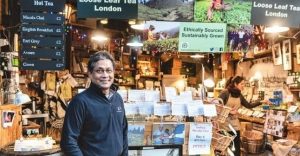 There are many reasons to visit the Borough Market; however, for my traveling companion, an aficionado of fine teas, the main drawing card was a visit to Tea2You, the best loose leaf tea seller in the United Kingdom. It was founded and is owned & operated by Ratan Mondal, a native of Kolkata, India, and a specialist purveyor of the finest Darjeeling varieties from the best tea gardens of the Indian sub-continent.
There are many reasons to visit the Borough Market; however, for my traveling companion, an aficionado of fine teas, the main drawing card was a visit to Tea2You, the best loose leaf tea seller in the United Kingdom. It was founded and is owned & operated by Ratan Mondal, a native of Kolkata, India, and a specialist purveyor of the finest Darjeeling varieties from the best tea gardens of the Indian sub-continent.
All the teas are ethically grown and sustainably sourced from gardens in Darjeeling and have been sampled and carefully selected and tasted by Mr. Modal, an expert and experienced tea taster. He works with a select number of small/medium tea farmers to promote sustainability and personally travels to the plantations in order to maintain traceability and ascertain authenticity. Avid tea drinkers, please take note. No visit to London would be complete without a visit to Tea2You.
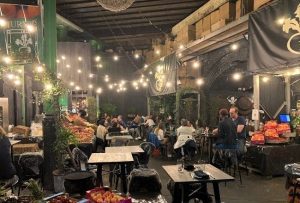 A final note: When it comes to eating and drinking, there are numerous options in and around the market. Quite by accident I stumbled upon Turnips – which I subsequently learned had been a mainstay in the market for over thirty years – where we enjoyed an absolutely delicious lunch of small plates (a complete review will be posted in an article to follow).
A final note: When it comes to eating and drinking, there are numerous options in and around the market. Quite by accident I stumbled upon Turnips – which I subsequently learned had been a mainstay in the market for over thirty years – where we enjoyed an absolutely delicious lunch of small plates (a complete review will be posted in an article to follow).
Courtauld Gallery: Located just a few short blocks from our hotel, the Courtauld Gallery is an art museum in Somerset House (the former repository of vital statistics – births, deaths, marriages, etc. – for the United Kingdom). It is home to the collection of the Courtauld Institute of Art, a self-governing college of the University of London specializing in the study of art history. It is particularly known for its French Impressionist and Post-Impressionist paintings. The collection contains some 530 paintings and over 26,000 drawings and prints.
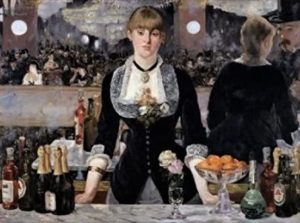 The Courtauld Institute was founded in 1932 through the philanthropic efforts of industrialist and art collector Samuel Courtauld, diplomat and collector Lord Lee of Fareham, and art historian Sir Robert Witt. The original collection was begun by Samuel Courtauld who, in the same year, presented an extensive collection of paintings. He also made further gifts later in the 1930s and a bequest in 1948.
The Courtauld Institute was founded in 1932 through the philanthropic efforts of industrialist and art collector Samuel Courtauld, diplomat and collector Lord Lee of Fareham, and art historian Sir Robert Witt. The original collection was begun by Samuel Courtauld who, in the same year, presented an extensive collection of paintings. He also made further gifts later in the 1930s and a bequest in 1948.
The Courtauld’s permanent collection ranges from the Middle Ages to the 20th century and includes such masterpieces as Manet’s A Bar at the Folies-Bergère (pictured), Van Gogh’s Self-Portrait with Bandaged Ear, and the most significant collection of works by Cézanne in the UK presented alongside paintings by such artists as Gauguin, Renoir, and Monet.
The Blavatnik Fine Rooms, spanning the entirety of the second floor, contain a series of new displays of works from the Renaissance to the 18th century. Highlights include Adam and Eve by Lucas Cranach the Elder, The Descent from the Cross by Peter Paul Rubens, The Trinity with Saints altarpiece by Sandro Botticelli, and Landscape with a flight into Egypt by Pieter Bruegel the Elder.
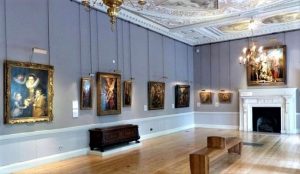 In 1978, the Courtauld received the Princes Gate Collection of Old Master paintings and drawings formed by Count Antoine Seilern, which rivals the Samuel Courtauld Collection in importance. It includes paintings by Bernardo Daddi, Robert Campin, Bruegel, Quentin Matsys, Van Dyck and Tiepolo… But the collection is strongest in the works of Peter Paul Rubens.
In 1978, the Courtauld received the Princes Gate Collection of Old Master paintings and drawings formed by Count Antoine Seilern, which rivals the Samuel Courtauld Collection in importance. It includes paintings by Bernardo Daddi, Robert Campin, Bruegel, Quentin Matsys, Van Dyck and Tiepolo… But the collection is strongest in the works of Peter Paul Rubens.
Rubens’s major paintings were often gargantuan in scope. However, such works would often begin as a modello, an oil sketch painted on a small panel, after which he would make preparatory drawings of individual figures within the composition. And an entire room on the museum’s second floor, Rubens at Work, is dedicated to these fascinatingly diminutive works of art.
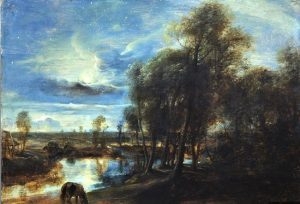 Rubens was considered the most influential artist of the Flemish Baroque tradition. His commissioned works were mostly historical paintings, which included religious and mythological subjects and hunt scenes. He also painted a variety of portraits, especially of friends, and self-portraits (as the one noted above).
Rubens was considered the most influential artist of the Flemish Baroque tradition. His commissioned works were mostly historical paintings, which included religious and mythological subjects and hunt scenes. He also painted a variety of portraits, especially of friends, and self-portraits (as the one noted above).
In the final years of his life, however, Rubens purchased a country estate outside the Flemish city of Antwerp called Het Steen; and it was here that his interest turned to landscapes, for his own pleasure rather than on commission. And it is in the stunningly beautiful nocturnal solitude of his Landscape by Moonlight (pictured) that the artist’s powers of invention and originality in landscapes reached their peak. Rubens had initially included biblical figures in the foreground but painted them out to make this work a pure landscape. A grazing horse in the foreground is the only living creature to remain.
In the 18th century, Landscape by Moonlight belonged to Joshua Reynolds, first president of the Royal Academy, who used it as an example of his lectures on art. The painting also had a powerful influence upon British landscape painters such as John Constable.
Bon Appétit!
Be Safe & Stay Well
TAD

{ 0 comments… add one now }